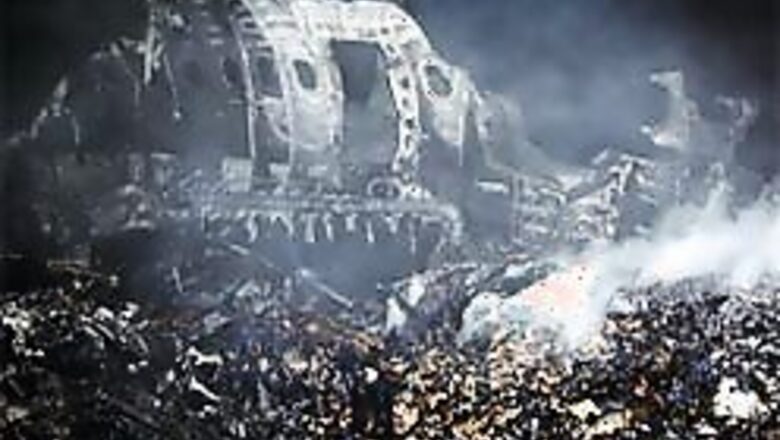
views
Khartoum (Sudan): Sudanese state television says that around 100 people were killed when a plane exploded into fire after landing at Khartoum's international airport on Wednesday.
There was no further official information on the accident, but about 200 passengers were thought to be aboard the plane when it landed in bad weather and a higher casualty.
The Sudanese Airbus carrying 214 people veered off the runway in a thunderstorm and burst into flames late Tuesday.
Officials said more than 100 people fled the plane before it was engulfed by towering orange flames.
An Associated Press reporter at the scene said the Sudan Airways jetliner appeared to have left the runway after landing at Khartoum International Airport, and several loud explosions resounded as fire raced through the aircraft.
The roaring blaze dwarfed the Airbus A310's shattered fuselage as firefighters sprayed water with little apparent effect, Sudanese TV footage showed. Ambulances and firetrucks rushed to the scene, and media were kept away.
The Civil Aviation Authority confirmed that 103 passengers and all 11 crew members survived. In addition, it said some other passengers may have gone home directly after the crew helped them through the emergency doors. Officials said most aboard were Sudanese.
Death toll reports conflicted. State TV initially said about 100 were killed, but officials later put the toll at dozens without being more precise. Deputy parliament speaker Mohammed al-Hassan al-Ameen said ''about 30 people'' died, while police spokesman Mohammed Abdel Majid al-Tayeb said 23 bodies were brought to the morgue.
''There are missing passengers who could be still inside the plane, or left the aircraft but did not inform officials,'' al-Tayeb said.
A survivor speaking at the airport to Sudanese TV said the landing was ''rough,'' and there was a sharp impact several minutes later.
''The right wing was on fire,'' said the passenger, who did not give his name. He said smoke got into the cockpit and some people started opening the emergency exits. Soon, fire engulfed the plane, he said.
The cause of the accident wasn't immediately known and there were differing reports on the role weather played.
A sandstorm had hit the area with 20 mph winds between 2 p.m. and 3 p.m. and there was a thunderstorm and similar winds at the time of the crash around 9 p.m., said Elaine Yang, a meterologist with the San Francisco-based Weather Underground, a private weather service.
The Sudanese ambassador to Washington called the weather ''very bad'' and said the runway had been drenched by rain.
''There was a lot of water on the runway and they still tried to land,'' Ambassador John Ukec Lueth Ukec said.
The head of Sudanese police, Mohammad Najib, said bad weather ''caused the plane to crash land, split into two and catch fire.''
Youssef Ibrahim, director of the Khartoum airport, disputed that bad weather caused the crash. He told Sudanese TV that the plane ''landed safely'' and the pilot was talking to the control tower and getting further instructions when the accident occurred.
''One of the (plane's) engines exploded and the plane caught fire,'' Ibrahim said. He blamed the accident on technical problems, but didn't elaborate.
Raqeeb Abdel-Latif, head of the Sudan Airways office in Damascus, Syria, said the plane, which joined the Sudanese national carrier seven months ago, took off from Damascus and stopped in Amman, Jordan, where 34 additional passengers came on board.
Due to inclement weather, the aircraft stopped at Port Sudan Airport along the Red Sea, picking up 35 passengers and refueling before heading back to Khartoum, the Sudanese ambassador said in Washington.
Spokesmen for the Federal Aviation Administration and the National Transportation Safety Board in Washington said they were monitoring the situation. The Khartoum airport was shut down until Wednesday morning, officials said.
Sudan has a poor aviation safety record. In May, a plane crash in a remote area of southern Sudan killed 24 people, including key members of the southern Sudanese government. In July 2003, a Sudan Airways Boeing 737 en route from Port Sudan to Khartoum crashed soon after takeoff, killing all 115 people on board.
After that crash, Sudanese officials blamed sanctions for restricting vital aircraft parts. The U.S. State Department said there was no ban on equipment needed for aviation safety.
In 1997, then-President Clinton issued an executive order barring the export of goods and technology to Sudan because of the country's ''support for international terrorism, ongoing efforts to destabilize neighboring governments, and the prevalence of human rights violations.''
The U.N. Security Council has imposed an embargo on providing arms or military training to armed groups in Sudan's Darfur region and a travel ban and asset freeze on some people implicated in the violence there.
The Airbus A310 is a twin-engine, widebody plane used by a number of carriers around the world. Typically configured with about 220 seats, it is a shorter version of the popular A300.
An Airbus spokesman in Paris declined immediate comment on the crash.
In July 2006, an A310 operated by Russia's S7 Airlines went off the runway after landing in Irkutsk, smashed into adjacent buildings and caught fire, killing 123 of the 203 people aboard.
Although deaths from air travel have fallen over the past two years, the number of serious jetliner accidents increased last year for the first time in a decade, according to a report last month by the International Air Transport Association. Nearly half of all jet accidents occurred on landing in 2007.













Comments
0 comment